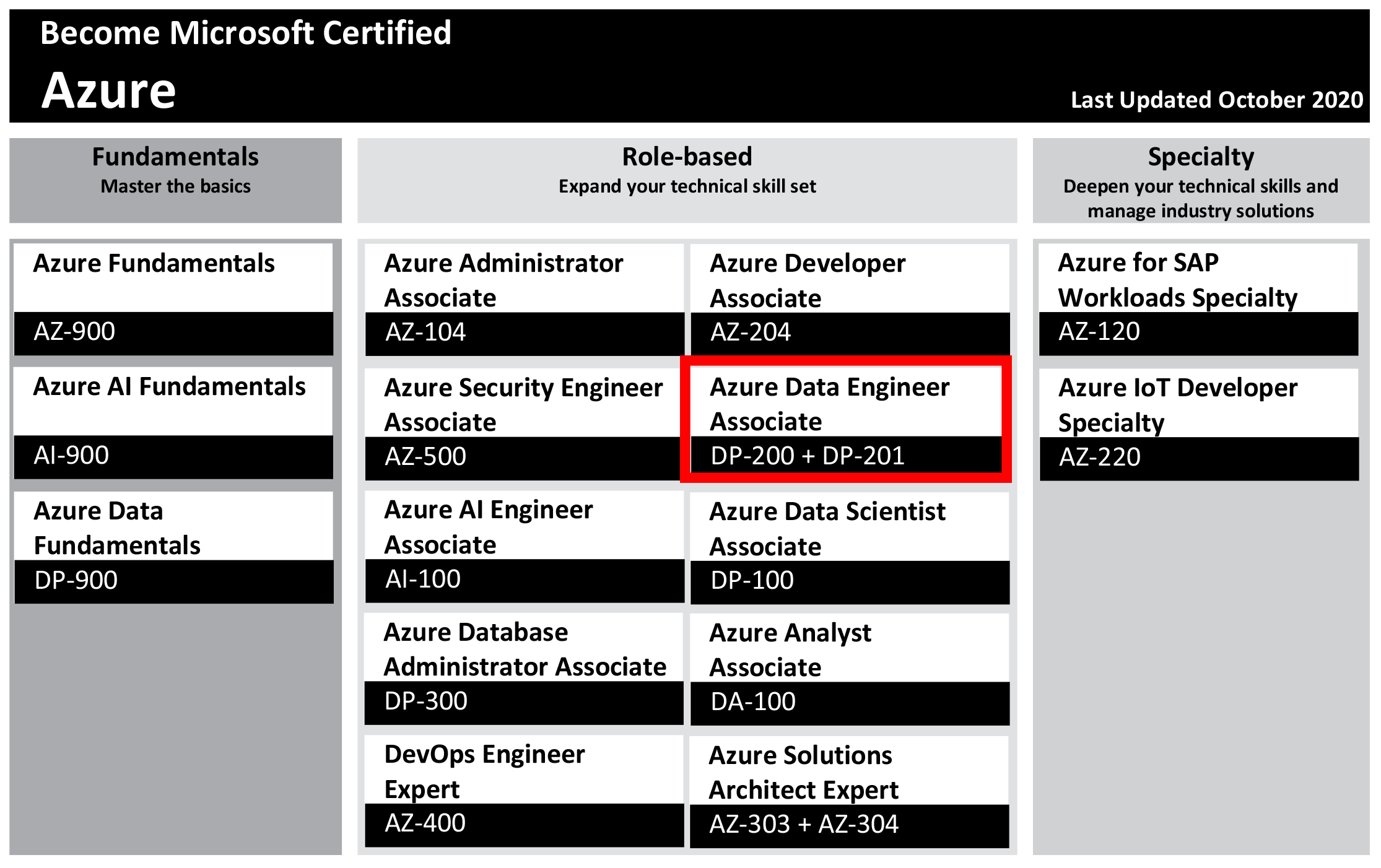DP-200-201 - Microsoft Certified: Azure Data Engineer Associate
Microsoft cours officiels
Home » ISEIG Cours » DP-200-201 – Microsoft Certified: Azure Data Engineer Associate
Ces cours sont dispensés en français sur la base d'une documentation pédagogique en anglais ou en français si elle est traduite.
These 2 courses of respectively 3 and 2 days are designed for IT Professionals who will learn how to implement various data platform technologies into solutions that are in line with business and technical requirements including on-premises, cloud, and hybrid data scenarios incorporating both relational and No-SQL data.
These courses help prepare for the exams « DP-200 - Implementing an Azure Data Solution » and « DP-201: Designing an Azure Data Solution » to obtain the title « Microsoft Certified: Azure Data Engineer Associate ».
These 2 courses of respectively 3 and 2 days are designed for IT Professionals who will learn how to implement various data platform technologies into solutions that are in line with business and technical requirements including on-premises, cloud, and hybrid data scenarios incorporating both relational and No-SQL data.
These courses help prepare for the exams « DP-200 - Implementing an Azure Data Solution » and « DP-201: Designing an Azure Data Solution » to obtain the title « Microsoft Certified: Azure Data Engineer Associate ».

Modules et dates
These 2 courses of respectably 3 and 2 days are given once a semester, 1 to 2 days a week, from 9:00 am to 12:00 pm and from 1:30 pm to 5:00 pm.
DP-200 - Implementing an Azure Data Solution
Durée
3
Prix
CHF 2'250.-
Prix/j.
CHF 750.-
Cycle 1
on demand
DP-201 - Designing an Azure Data Solution
Durée
2
Prix
CHF 1'600.-
Prix/j.
CHF 800.-
Cycle 1
on demand
These courses are given in French on the basis of documentation in French if available (Fra) or in English (Eng). If it is available in both languages, the French version is distributed unless specifically requested by the interested party. The price of the course includes all the pedagogical documentation distributed.
DP-200 - Implementing an Azure Data Solution
Overview
The students will:
- implement various data platform technologies into solutions that are in line with business and technical requirements including on-premises, cloud, and hybrid data scenarios incorporating both relational and No-SQL data.
- learn how to process data using a range of technologies and languages for both streaming and batch data
- explore how to implement data security including authentication, authorization, data policies and standards
- define and implement data solution monitoring for both the data storage and data processing activities.
- manage and troubleshoot Azure data solutions which includes the optimization and disaster recovery of big data, batch processing and streaming data solutions.
Target Audience :
The primary audience for this course is:
- data professionals
- data architects
- data architects
- individuals who develop applications that deliver content from the data platform technologies that exist on Microsoft Azure
Objectives :
After completing this course, students will be able to:
- Explain the evolving world of data
- Survey the services in the Azure Data Platform
- Identify the tasks that are performed by a Data Engineer
- Describe the use cases for the cloud in a Case Study
- Choose a data storage approach in Azure
- Create an Azure Storage Account
- Explain Azure Data Lake Storage
- Upload data into Azure Data Lake
- Explain Azure Databricks
- Work with Azure Databricks
- Read data with Azure Databricks
- Perform transformations with Azure Databricks
- Create an Azure Cosmos DB database built to scale
- Insert and query data in your Azure Cosmos DB database
- Build a .NET Core app for Azure Cosmos DB in Visual Studio Code
- Distribute your data globally with Azure Cosmos DB
- Use Azure SQL Database
- Describe Azure Data Warehouse
- Creating and Querying an Azure SQL Data Warehouse
- Using PolyBase to Load Data into Azure SQL Data Warehouse
- Explain data streams and event processing
- Data Ingestion with Event Hubs
- Processing Data with Stream Analytics Jobs
- Azure Data Factory and Databricks
- Azure Data Factory Components
- Explain how Azure Data Factory works
- An introduction to security
- Key security components
- Securing Storage Accounts and Data Lake Storage
- Securing Data Stores
- Securing Streaming Data
- Explain the monitoring capabilities that are available
- Troubleshoot common data storage issues
- Troubleshoot common data processing issues
- Manage disaster recovery
Prerequisites :
In addition to their professional experience, students who take this training should have technical knowledge equivalent to the following courses:
- Azure fundamentals
Program :
This course is composed of 15 modules including lessons and practical work (lab).
- Azure for the Data Engineer
- Working with Data Storage
- Enabling Team Based Data Science with Azure Databricks
- Building Globally Distributed Databases with Cosmos DB
- Working with Relational Data Stores in the Cloud
- Performing Real-Time Analytics with Stream Analytics
- Orchestrating Data Movement with Azure Data Factory
- Securing Azure Data Platforms
- Monitoring and Troubleshooting Data Storage and Processing
- Data Platform Architecture Considerations
- Azure Batch Processing Reference Architectures
- Azure Real-Time Reference Architectures
- Data Platform Security Design Considerations
- Designing for Resiliency and Scale
- Design for Efficiency and Operations
Module 1: Azure for the Data Engineer
This module explores how the world of data has evolved and how cloud data platform technologies are providing new opportunities for business to explore their data in different ways. The student will gain an overview of the various data platform technologies that are available, and how a Data Engineers role and responsibilities has evolved to work in this new world to an organization benefit
Lessons
Module 2: Working with Data Storage
This module teaches the variety of ways to store data in Azure. The Student will learn the basics of storage management in Azure, how to create a Storage Account, and how to choose the right model for the data you want to store in the cloud. They will also understand how data lake storage can be created to support a wide variety of big data analytics solutions with minimal effort.
Lessons
Module 3: Enabling Team Based Data Science with Azure Databricks
This module introduces students to Azure Databricks and how a Data Engineer works with it to enable an organization to perform Team Data Science projects. They will learn the fundamentals of Azure Databricks and Apache Spark notebooks; how to provision the service and workspaces and learn how to perform data preparation task that can contribute to the data science project.
Lessons
Module 4: Building Globally Distributed Databases with Cosmos DB
In this module, students will learn how to work with NoSQL data using Azure Cosmos DB. They will learn how to provision the service, and how they can load and interrogate data in the service using Visual Studio Code extensions, and the Azure Cosmos DB .NET Core SDK. They will also learn how to configure the availability options so that users are able to access the data from anywhere in the world.
Lessons
Module 5: Working with Relational Data Stores in the Cloud
In this module, students will explore the Azure relational data platform options including SQL Database and SQL Data Warehouse. The student will be able explain why they would choose one service over another, and how to provision, connect and manage each of the services.
Lessons
Module 6: Performing Real-Time Analytics with Stream Analytics
In this module, students will learn the concepts of event processing and streaming data and how this applies to Events Hubs and Azure Stream Analytics. The students will then set up a stream analytics job to stream data and learn how to query the incoming data to perform analysis of the data. Finally, you will learn how to manage and monitor running jobs.
Lessons
Module 7: Orchestrating Data Movement with Azure Data Factory
In this module, students will learn how Azure Data factory can be used to orchestrate the data movement and transformation from a wide range of data platform technologies. They will be able to explain the capabilities of the technology and be able to set up an end to end data pipeline that ingests and transforms data.
Lessons
Module 8: Securing Azure Data Platforms
In this module, students will learn how Azure provides a multi-layered security model to protect your data. The students will explore how security can range from setting up secure networks and access keys, to defining permission through to monitoring across a range of data stores.
Lessons
Module 9: Monitoring and Troubleshooting Data Storage and Processing
In this module, the student will get an overview of the range of monitoring capabilities that are available to provide operational support should there be issue with a data platform architecture. They will explore the common data storage and data processing issues. Finally, disaster recovery options are revealed to ensure business continuity.
Lessons
Module 10: Data Platform Architecture Considerations
In this module, the students will learn how to design and build secure, scalable and performant solutions in Azure by examining the core principles found in every good architecture. They will learn how using key principles throughout your architecture regardless of technology choice, can help you design, build, and continuously improve your architecture for an organizations benefit.
Lessons
Module 11: Azure Batch Processing Reference Architectures
In this module, the student will learn the reference design and architecture patterns for dealing with the batch processing of data. The student will be exposed to dealing with the movement of data from on-premises systems into a cloud data warehouse and how it can be automated. The student will also be exposed to an AI architecture and how the data platform can integrate with an AI solution.
Lessons
Module 12: Azure Real-Time Reference Architectures
In this module, the student will learn the reference design and architecture patterns for dealing with streaming data. They will learn how streaming data can be ingested by Event Hubs and Stream Analytics to deliver real-time analysis of data. They will also explore a data science architecture the streams data into Azure Databricks to perform trend analysis. They will finally learn how an Internet of Things (IoT) architecture will require data platform technologies to store data.
Lessons
Module 13: Data Platform Security Design Considerations
In this module, the student will learn how to incorporate security into an architecture design and learn the key decision points in Azure provides to help you create a secure environment through all the layers of your architecture.
Lessons
Module 14: Designing for Resiliency and Scale
In this module, student will learn scaling services to handle load. They will learn how identifying network bottlenecks and optimizing your storage performance are important to ensure your users have the best experience. They will also learn how to handle infrastructure and service failure, recover from the loss of data, and recover from a disaster by designing availability and recoverability into your architecture.
Lessons
Module 15: Design for Efficiency and Operations
In this module, students will learn how to design an Azure architecture that is operationally-efficient and minimizes costs by reducing spend, they will understand how to design architectures that eliminates waste and gives them full visibility into what is being utilized in your organizations Azure environment.
Lessons
This module explores how the world of data has evolved and how cloud data platform technologies are providing new opportunities for business to explore their data in different ways. The student will gain an overview of the various data platform technologies that are available, and how a Data Engineers role and responsibilities has evolved to work in this new world to an organization benefit
Lessons
- Explain the evolving world of data
- Survey the services in the Azure Data Platform
- Identify the tasks that are performed by a Data Engineer
- Describe the use cases for the cloud in a Case Study
- Identify the evolving world of data
- Determine the Azure Data Platform Services
- Identify tasks to be performed by a Data Engineer
- Finalize the data engineering deliverables
- Explain the evolving world of data
- Survey the services in the Azure Data Platform
- Identify the tasks that are performed by a Data Engineer
- Describe the use cases for the cloud in a Case Study
Module 2: Working with Data Storage
This module teaches the variety of ways to store data in Azure. The Student will learn the basics of storage management in Azure, how to create a Storage Account, and how to choose the right model for the data you want to store in the cloud. They will also understand how data lake storage can be created to support a wide variety of big data analytics solutions with minimal effort.
Lessons
- Choose a data storage approach in Azure
- Create an Azure Storage Account
- Explain Azure Data Lake storage
- Upload data into Azure Data Lake
- Choose a data storage approach in Azure
- Create a Storage Account
- Explain Data Lake Storage
- Upload data into Data Lake Store
- Choose a data storage approach in Azure
- Create an Azure Storage Account
- Explain Azure Data Lake Storage
- Upload data into Azure Data Lake
Module 3: Enabling Team Based Data Science with Azure Databricks
This module introduces students to Azure Databricks and how a Data Engineer works with it to enable an organization to perform Team Data Science projects. They will learn the fundamentals of Azure Databricks and Apache Spark notebooks; how to provision the service and workspaces and learn how to perform data preparation task that can contribute to the data science project.
Lessons
- Explain Azure Databricks
- Work with Azure Databricks
- Read data with Azure Databricks
- Perform transformations with Azure Databricks
- Explain Azure Databricks
- Work with Azure Databricks
- Read data with Azure Databricks
- Perform transformations with Azure Databricks
- Explain Azure Databricks
- Work with Azure Databricks
- Read data with Azure Databricks
- Perform transformations with Azure Databricks
Module 4: Building Globally Distributed Databases with Cosmos DB
In this module, students will learn how to work with NoSQL data using Azure Cosmos DB. They will learn how to provision the service, and how they can load and interrogate data in the service using Visual Studio Code extensions, and the Azure Cosmos DB .NET Core SDK. They will also learn how to configure the availability options so that users are able to access the data from anywhere in the world.
Lessons
- Create an Azure Cosmos DB database built to scale
- Insert and query data in your Azure Cosmos DB database
- Build a .NET Core app for Cosmos DB in Visual Studio Code
- Distribute your data globally with Azure Cosmos DB
- Create an Azure Cosmos DB
- Insert and query data in Azure Cosmos DB
- Build a .Net Core App for Azure Cosmos DB using VS Code
- Distribute data globally with Azure Cosmos DB
- Create an Azure Cosmos DB database built to scale
- Insert and query data in your Azure Cosmos DB database
- Build a .NET Core app for Azure Cosmos DB in Visual Studio Code
- Distribute your data globally with Azure Cosmos DB
Module 5: Working with Relational Data Stores in the Cloud
In this module, students will explore the Azure relational data platform options including SQL Database and SQL Data Warehouse. The student will be able explain why they would choose one service over another, and how to provision, connect and manage each of the services.
Lessons
- Use Azure SQL Database
- Describe Azure SQL Data Warehouse
- Creating and Querying an Azure SQL Data Warehouse
- Use PolyBase to Load Data into Azure SQL Data Warehouse
- Use Azure SQL Database
- Describe Azure SQL Data Warehouse
- Creating and Querying an Azure SQL Data Warehouse
- Use PolyBase to Load Data into Azure SQL Data Warehouse
- Use Azure SQL Database
- Describe Azure Data Warehouse
- Creating and Querying an Azure SQL Data Warehouse
- Using PolyBase to Load Data into Azure SQL Data Warehouse
Module 6: Performing Real-Time Analytics with Stream Analytics
In this module, students will learn the concepts of event processing and streaming data and how this applies to Events Hubs and Azure Stream Analytics. The students will then set up a stream analytics job to stream data and learn how to query the incoming data to perform analysis of the data. Finally, you will learn how to manage and monitor running jobs.
Lessons
- Explain data streams and event processing
- Data Ingestion with Event Hubs
- Processing Data with Stream Analytics Jobs
- Explain data streams and event processing
- Data Ingestion with Event Hubs
- Processing Data with Stream Analytics Jobs
- Explain data streams and event processing
- Data Ingestion with Event Hubs
- Processing Data with Stream Analytics Jobs
Module 7: Orchestrating Data Movement with Azure Data Factory
In this module, students will learn how Azure Data factory can be used to orchestrate the data movement and transformation from a wide range of data platform technologies. They will be able to explain the capabilities of the technology and be able to set up an end to end data pipeline that ingests and transforms data.
Lessons
- Explain how Azure Data Factory works
- Azure Data Factory Components
- Azure Data Factory and Databricks
- Explain how Data Factory Works
- Azure Data Factory Components
- Azure Data Factory and Databricks
- Azure Data Factory and Databricks
- Azure Data Factory Components
- Explain how Azure Data Factory works
Module 8: Securing Azure Data Platforms
In this module, students will learn how Azure provides a multi-layered security model to protect your data. The students will explore how security can range from setting up secure networks and access keys, to defining permission through to monitoring across a range of data stores.
Lessons
- An introduction to security
- Key security components
- Securing Storage Accounts and Data Lake Storage
- Securing Data Stores
- Securing Streaming Data
- An introduction to security
- Key security components
- Securing Storage Accounts and Data Lake Storage
- Securing Data Stores and Streaming Data
- An introduction to security
- Key security components
- Securing Storage Accounts and Data Lake Storage
- Securing Data Stores and Streaming Data
Module 9: Monitoring and Troubleshooting Data Storage and Processing
In this module, the student will get an overview of the range of monitoring capabilities that are available to provide operational support should there be issue with a data platform architecture. They will explore the common data storage and data processing issues. Finally, disaster recovery options are revealed to ensure business continuity.
Lessons
- Explain the monitoring capabilities that are available
- Troubleshoot common data storage issues
- Troubleshoot common data processing issues
- Manage disaster recovery
- Explain the monitoring capabilities that are available
- Troubleshoot common data storage issues
- Troubleshoot common data processing issues
- Manage disaster recovery
- Explain the monitoring capabilities that are available
- Troubleshoot common data storage issues
- Troubleshoot common data processing issues
- Manage disaster recovery
Module 10: Data Platform Architecture Considerations
In this module, the students will learn how to design and build secure, scalable and performant solutions in Azure by examining the core principles found in every good architecture. They will learn how using key principles throughout your architecture regardless of technology choice, can help you design, build, and continuously improve your architecture for an organizations benefit.
Lessons
- Core Principles of Creating Architectures
- Design with Security in Mind
- Performance and Scalability
- Design for availability and recoverability
- Design for efficiency and operations
- Case Study
- Design with security in mind
- Consider performance and scalability
- Design for availability and recoverability
- Design for efficiency and operations
- Design with Security in mind
- Consider performance and scalability
- Design for availability and recoverability
- Design for efficiency and operations
Module 11: Azure Batch Processing Reference Architectures
In this module, the student will learn the reference design and architecture patterns for dealing with the batch processing of data. The student will be exposed to dealing with the movement of data from on-premises systems into a cloud data warehouse and how it can be automated. The student will also be exposed to an AI architecture and how the data platform can integrate with an AI solution.
Lessons
- Lambda architectures from a Batch Mode Perspective
- Design an Enterprise BI solution in Azure
- Automate enterprise BI solutions in Azure
- Architect an Enterprise-grade Conversational Bot in Azure
- Designing an Enterprise BI solution in Azure
- Automate an Enterprise BI solution in Azure
- Automate an Enterprise BI solution in Azure
- Core Principles of Creating Architectures
- Describe Lambda architectures from a Batch Mode Perspective
- Design an Enterprise BI solution in Azure
- Automate enterprise BI solutions in Azure
- Architect an Enterprise-grade conversational bot in Azure
- Case study
Module 12: Azure Real-Time Reference Architectures
In this module, the student will learn the reference design and architecture patterns for dealing with streaming data. They will learn how streaming data can be ingested by Event Hubs and Stream Analytics to deliver real-time analysis of data. They will also explore a data science architecture the streams data into Azure Databricks to perform trend analysis. They will finally learn how an Internet of Things (IoT) architecture will require data platform technologies to store data.
Lessons
- Lambda architectures for a Real-Time Perspective
- Architect a stream processing pipeline with Azure Stream Analytics
- Design a stream processing pipeline with Azure Databricks
- Create an Azure IoT reference architecture
- Architect a stream processing pipeline with Azure Stream Analytics
- Design a stream processing pipeline with Azure Databricks
- Create an Azure IoT reference architecture
- Lambda architectures for a Real-Time Mode Perspective
- Architect a stream processing pipeline with Azure Stream Analytics
- Design a stream processing pipeline with Azure Databricks
- Create an Azure IoT reference architecture
Module 13: Data Platform Security Design Considerations
In this module, the student will learn how to incorporate security into an architecture design and learn the key decision points in Azure provides to help you create a secure environment through all the layers of your architecture.
Lessons
- Defense in Depth Security Approach
- Identity Management
- Infrastructure Protection
- Encryption Usage
- Network Level Protection
- Application Security
- Defense in Depth Security Approach
- Identity Protection
- Defense in Depth Security Approach
- Identity Management
- Infrastructure Protection
- Encryption Usage
- Network Level Protection
- Application Security
Module 14: Designing for Resiliency and Scale
In this module, student will learn scaling services to handle load. They will learn how identifying network bottlenecks and optimizing your storage performance are important to ensure your users have the best experience. They will also learn how to handle infrastructure and service failure, recover from the loss of data, and recover from a disaster by designing availability and recoverability into your architecture.
Lessons
- Adjust Workload Capacity by Scaling
- Optimize Network Performance
- Design for Optimized Storage and Database Performance
- Identifying Performance Bottlenecks
- Design a Highly Available Solution
- Incorporate Disaster Recovery into Architectures
- Design Backup and Restore strategies
- Adjust Workload Capacity by Scaling
- Design for Optimized Storage and Database Performance
- Design a Highly Available Solution
- Incorporate Disaster Recovery into Architectures
- Adjust Workload Capacity by Scaling
- Optimize Network Performance
- Design for Optimized Storage and Database Performance
- Identifying Performance Bottlenecks
- Design a Highly Available Solution
- Incorporate Disaster Recovery into Architectures
- Design Backup and Restore strategies
Module 15: Design for Efficiency and Operations
In this module, students will learn how to design an Azure architecture that is operationally-efficient and minimizes costs by reducing spend, they will understand how to design architectures that eliminates waste and gives them full visibility into what is being utilized in your organizations Azure environment.
Lessons
- Maximizing the Efficiency of your Cloud Environment
- Use Monitoring and Analytics to Gain Operational Insights
- Use Automation to Reduce Effort and Error
- Maximize the Efficiency of your Cloud Environment
- Use Monitoring and Analytics to Gain Operational Insights
- Use Automation to Reduce Effort and Error
- Maximize the Efficiency of your Cloud Environment
- Use Monitoring and Analytics to Gain Operational Insights
- Use Automation to Reduce Effort and Error
DP-201 - Designing an Azure Data Solution
Overview
The students will:
- design various data platform technologies into solutions that are in line with business and technical requirements
- learn how to design process architectures using a range of technologies for both streaming and batch data
- explore how to design data security including data access, data policies and standards
- design Azure data solutions which includes the optimization, availability and disaster recovery of big data, batch processing and streaming data solutions.
Target Audience :
- data professionals
- data architects
- business intelligence professionals
- individuals who develop applications that deliver content from the data platform technologies that exist on Microsoft Azure.
Objectives :
After completing this course, students will be able to:
- Design with Security in mind
- Consider performance and scalability
- Design for availability and recoverability
- Design for efficiency and operations
- Core Principles of Creating Architectures
- Describe Lambda architectures from a Batch Mode Perspective
- Design an Enterprise BI solution in Azure
- Automate enterprise BI solutions in Azure
- Architect an Enterprise-grade conversational bot in Azure Case study
- Lambda architectures for a Real-Time Mode Perspective
- Architect a stream processing pipeline with Azure Stream Analytics
- Design a stream processing pipeline with Azure Databricks
- Create an Azure IoT reference architecture
- Defense in Depth Security Approach
- Identity Management
- Infrastructure Protection
- Encryption Usage
- Network Level Protection
- Application Security
- Adjust Workload Capacity by Scaling
- Optimize Network Performance
- Design for Optimized Storage and Database Performance
- Identifying Performance Bottlenecks
- Design a Highly Available Solution
- Incorporate Disaster Recovery into Architectures
- Design Backup and Restore strategies
- Maximize the Efficiency of your Cloud Environment
- Use Monitoring and Analytics to Gain Operational Insights
- Use Automation to Reduce Effort and Error
Prerequisites :
In addition to their professional experience, students who take this training should have technical knowledge equivalent to the following courses:
- Azure fundamentals
- DP-200: Implementing an Azure Data Solution
Program :
This course is composed of 6 modules including lessons and practical work (lab).
- Data Platform Architecture Considerations
- Azure Batch Processing Reference Architectures
- Azure Real-Time Reference Architectures
- Data Platform Security Design Considerations
- Designing for Resiliency and Scale
- Design for Efficiency and Operations
Module 1: Data Platform Architecture Considerations
In this module, the students will learn how to design and build secure, scalable and performant solutions in Azure by examining the core principles found in every good architecture. They will learn how using key principles throughout your architecture regardless of technology choice, can help you design, build, and continuously improve your architecture for an organizations benefit.
LessonsDesign with security in mind
Consider performance and scalability
Design for availability and recoverability
Design for efficiency and operationsv
After completing this module, students will be able to:
In this module, the student will learn the reference design and architecture patterns for dealing with the batch processing of data. The student will be exposed to dealing with the movement of data from on-premises systems into a cloud data warehouse and how it can be automated. The student will also be exposed to an AI architecture and how the data platform can integrate with an AI solution.
Lessons
Module 3: Azure Real-Time Reference Architectures
In this module, the student will learn the reference design and architecture patterns for dealing with streaming data. They will learn how streaming data can be ingested by Event Hubs and Stream Analytics to deliver real-time analysis of data. They will also explore a data science architecture the streams data into Azure Databricks to perform trend analysis. They will finally learn how an Internet of Things (IoT) architecture will require data platform technologies to store data
.Lessons
Module 4: Data Platform Security Design Considerations
In this module, the student will learn how to incorporate security into an architecture design and learn the key decision points in Azure provides to help you create a secure environment through all the layers of your architecture.
Lessons
Module 5: Designing for Resiliency and Scale
In this module, student will learn scaling services to handle load. They will learn how identifying network bottlenecks and optimizing your storage performance are important to ensure your users have the best experience. They will also learn how to handle infrastructure and service failure, recover from the loss of data, and recover from a disaster by designing availability and recoverability into your architecture.
Lessons
Module 6: Design for Efficiency and Operations
In this module, students will learn how to design an Azure architecture that is operationally-efficient and minimizes costs by reducing spend, they will understand how to design architectures that eliminates waste and gives them full visibility into what is being utilized in your organizations Azure environment.
Lessons
In this module, the students will learn how to design and build secure, scalable and performant solutions in Azure by examining the core principles found in every good architecture. They will learn how using key principles throughout your architecture regardless of technology choice, can help you design, build, and continuously improve your architecture for an organizations benefit.
Lessons
- Core Principles of Creating Architectures
- Design with Security in Mind
- Performance and Scalability
- Design for availability and recoverability
- Design for efficiency and operations
- Case Study
- Design with Security in mind
- Consider performance and scalability
- Design for availability and recoverability
- Design for efficiency and operations
In this module, the student will learn the reference design and architecture patterns for dealing with the batch processing of data. The student will be exposed to dealing with the movement of data from on-premises systems into a cloud data warehouse and how it can be automated. The student will also be exposed to an AI architecture and how the data platform can integrate with an AI solution.
Lessons
- Lambda architectures from a Batch Mode Perspective
- Design an Enterprise BI solution in Azure
- Automate enterprise BI solutions in Azure
- Architect an Enterprise-grade Conversational Bot in Azure
- Designing an Enterprise BI solution in Azure
- Automate an Enterprise BI solution in Azure
- Automate an Enterprise BI solution in Azure
- Core Principles of Creating Architectures
- Describe Lambda architectures from a Batch Mode Perspective
- Design an Enterprise BI solution in Azure
- Automate enterprise BI solutions in Azure
- Architect an Enterprise-grade conversational bot in Azure
- Case study
Module 3: Azure Real-Time Reference Architectures
In this module, the student will learn the reference design and architecture patterns for dealing with streaming data. They will learn how streaming data can be ingested by Event Hubs and Stream Analytics to deliver real-time analysis of data. They will also explore a data science architecture the streams data into Azure Databricks to perform trend analysis. They will finally learn how an Internet of Things (IoT) architecture will require data platform technologies to store data
.Lessons
- Lambda architectures for a Real-Time Perspective
- Architect a stream processing pipeline with Azure Stream Analytics
- Design a stream processing pipeline with Azure Databricks
- Create an Azure IoT reference architecture
- Architect a stream processing pipeline with Azure Stream Analytics
- Design a stream processing pipeline with Azure Databricks
- Create an Azure IoT reference architecture
- Lambda architectures for a Real-Time Mode Perspective
- Architect a stream processing pipeline with Azure Stream Analytics
- Design a stream processing pipeline with Azure Databricks
- Create an Azure IoT reference architecture
Module 4: Data Platform Security Design Considerations
In this module, the student will learn how to incorporate security into an architecture design and learn the key decision points in Azure provides to help you create a secure environment through all the layers of your architecture.
Lessons
- Defense in Depth Security Approach
- Identity Management
- Infrastructure Protection
- Encryption Usage
- Network Level Protection
- Application Security
- Defense in Depth Security Approach
- Identity Protection
- Defense in Depth Security Approach
- Identity Management
- Infrastructure Protection
- Encryption Usage
- Network Level Protection
- Application Security
Module 5: Designing for Resiliency and Scale
In this module, student will learn scaling services to handle load. They will learn how identifying network bottlenecks and optimizing your storage performance are important to ensure your users have the best experience. They will also learn how to handle infrastructure and service failure, recover from the loss of data, and recover from a disaster by designing availability and recoverability into your architecture.
Lessons
- Adjust Workload Capacity by Scaling
- Optimize Network Performance
- Design for Optimized Storage and Database Performance
- Identifying Performance Bottlenecks
- Design a Highly Available Solution
- Incorporate Disaster Recovery into Architectures
- Design Backup and Restore strategies
- Adjust Workload Capacity by Scaling
- Design for Optimized Storage and Database Performance
- Design a Highly Available Solution
- Incorporate Disaster Recovery into Architectures
- Adjust Workload Capacity by Scaling
- Optimize Network Performance
- Design for Optimized Storage and Database Performance
- Identifying Performance Bottlenecks
- Design a Highly Available Solution
- Incorporate Disaster Recovery into Architectures
- Design Backup and Restore strategies
Module 6: Design for Efficiency and Operations
In this module, students will learn how to design an Azure architecture that is operationally-efficient and minimizes costs by reducing spend, they will understand how to design architectures that eliminates waste and gives them full visibility into what is being utilized in your organizations Azure environment.
Lessons
- Maximizing the Efficiency of your Cloud Environment
- Use Monitoring and Analytics to Gain Operational Insights
- Use Automation to Reduce Effort and Error
- Maximize the Efficiency of your Cloud Environment
- Use Monitoring and Analytics to Gain Operational Insights
- Use Automation to Reduce Effort and Error
- Maximize the Efficiency of your Cloud Environment
- Use Monitoring and Analytics to Gain Operational Insights
- Use Automation to Reduce Effort and Error





